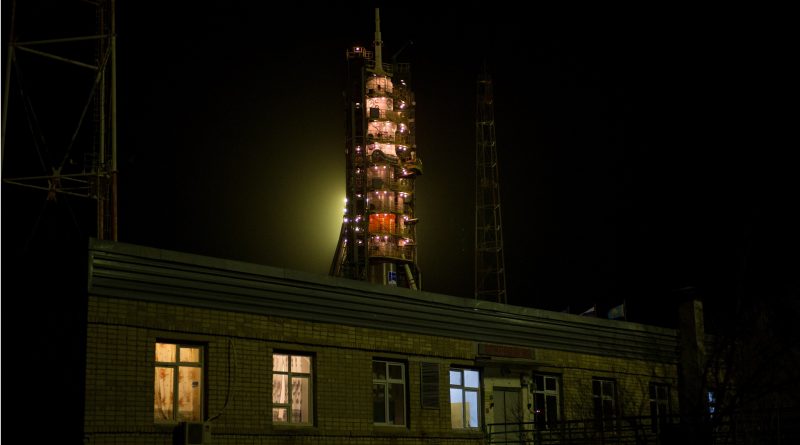Soyuz Trio on the Eve of Liftoff on half-year ISS Mission
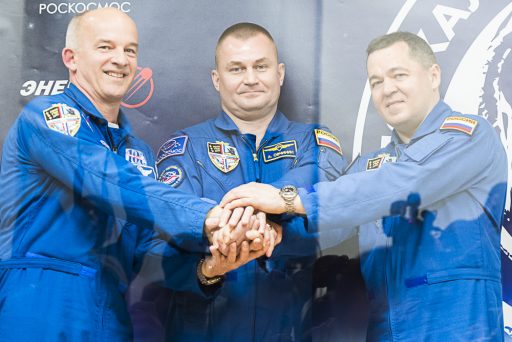
Two Russians and one American Astronaut are on the eve of their launch on a half-year space flight to the International Space Station, starting with a thundering nighttime liftoff atop a Soyuz FG rocket on Friday. Rookie Soyuz commander Alexey Ovchinin and veteran Flight Engineers Oleg Skripochka and Jeff Williams have been cleared for launch, being approved for flight by the Russian State Commission on Thursday.
The Soyuz FG rocket set to carry the 7,200 Kilogram Soyuz TMA-20M spacecraft into orbit was wheeled to the launch pad on Wednesday to start its final two days of launch preparations. Although the rocket had been rolled to the historic launch pad at Site 1/5 before dawn, it had to remain in a horizontal position until the evening because of strong winds.
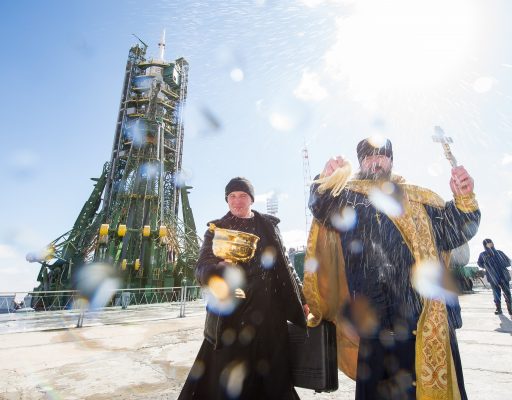
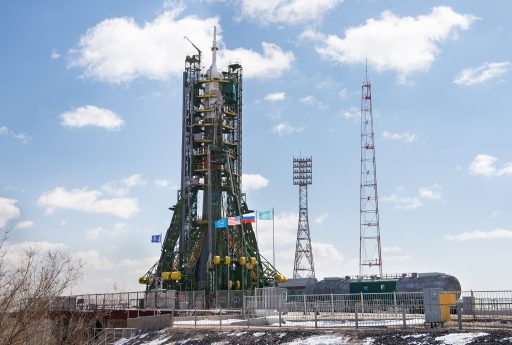
The Soyuz rocket received its traditional pre-flight blessing on Thursday and is ready to head into an eight-hour countdown operation on Friday to be fueled for liftoff at 21:26 UTC. Rising into the night skies over Baikonur, Soyuz FG will begin a high-speed chase of the Space Station that will pass over the launch site just minutes ahead of liftoff. Set for a nine-minute ride into orbit, Soyuz TMA-20M – the last in the TMA-M series of Soyuz spacecraft – is aiming for an orbit 200 Kilometers in altitude.
To support the fast-track rendezvous, Soyuz will perform a pair of engine burns on its first lap around Earth to begin raising its orbit straight away and commence the climb towards the orbiting outpost. Another pair of maneuvers is planned for the second orbit, adjusted based on measured orbital parameters to correct any errors occurring during launch. The fully automated rendezvous with ISS will be initiated on Orbit 3 as Soyuz activates its KURS systems to guide itself to ISS. Docking to the Poisk module is planned for 3:12 UTC on Saturday.
Hatch opening is expected a little under two hours after docking to mark the arrival of three new crew members, joining the resident crew of Expedition 47 Commander Tim Kopra and Flight Engineers Tim Peake and Yuri Malenchenko.
With years of training coming to an end, activities for the Soyuz trio were winding down over the past few days, allowing them to catch some rest and adjust their sleep cycles to be able to support their overnight countdown and launch. Their counterparts on ISS will go through sleep shifting on Friday to be awake when the Soyuz arrives.
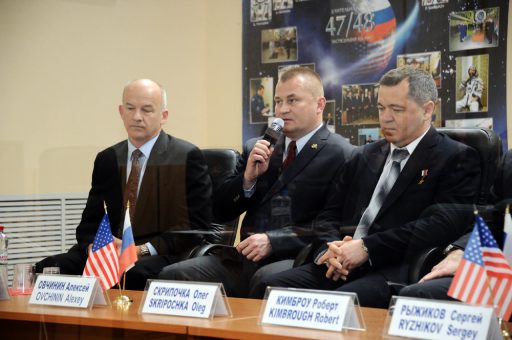
Over the past several days, the Soyuz TMA-20M crew participated in pre-flight meetings with Mission Control to prepare for operations upcoming aboard ISS. They also tagged up with recovery forces to be deployed along the ground track of the Soyuz to be able to reach the spacecraft quickly in the event of an ascent abort at any point from liftoff through spacecraft separation.
On Thursday, the Russian State Commission approved the three prime crew members for launch, marking their completion of training and pre-flight exams. A last pre-launch press conference was held at Site 254 of the Baikonur Cosmodrome before the crew went back to the Cosmonaut Hotel for a quiet evening. They will be able to sleep in on Friday, set to begin their personal launch preparations in the late afternoon, local time.
Countdown, Launch & Rendezvous Sequence
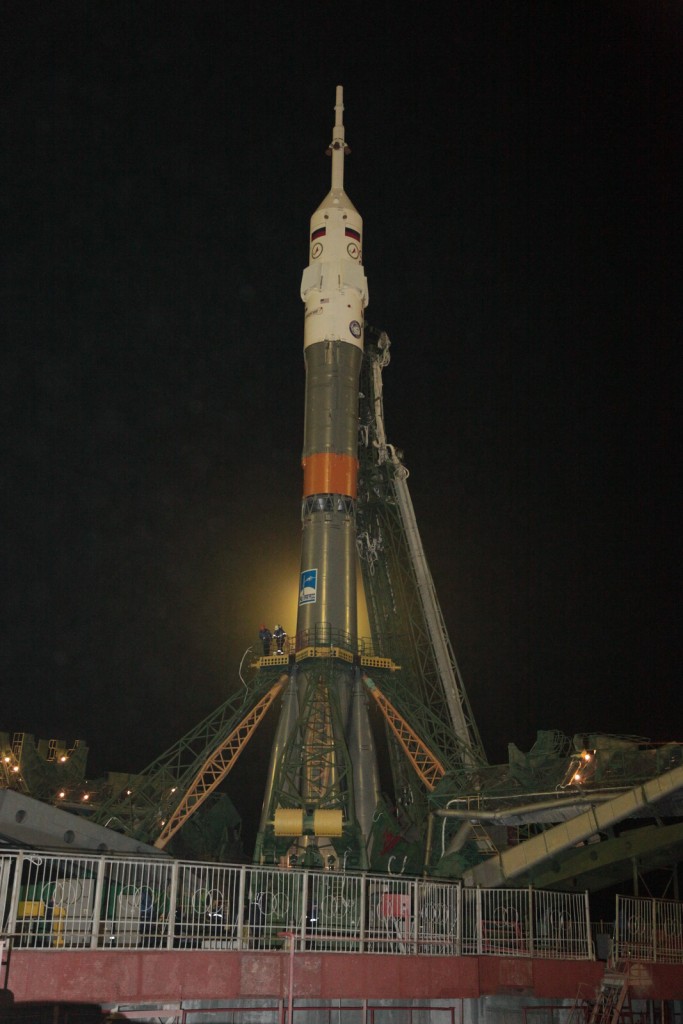
The crew will receive their wake-up calls around eight and a half hours prior to liftoff. Starting their day, the crew members typically plan much time for their final shower in the comforts of gravity for quite some time. The joys of flying to ISS begin with a whole-body disinfection to protect the carefully maintained environment aboard the Space Station, also requiring the crew to take microbial samples that are then analyzed as part of the various biological studies.
At the Cosmonaut Hotel, the crew will have breakfast before packing their things for handover to their families since all their luggage is already aboard ISS or packed inside the Soyuz. They will then sign their hotel room doors and prepare to depart the Cosmonaut Hotel for the suit-up facility, receiving the traditional pre-flight blessing when leaving the hotel at L-6 hours.
Out at Site 1/5, engineers will initiate the countdown sequence around eight hours prior to launch with the final set of fueling preparations. The eight-hour countdown process includes all steps needed to transition the Soyuz rocket and spacecraft to a launch configuration, beginning with the activation of the Soyuz launcher and spacecraft’s Flight Control System for checkouts.
Once the two vehicles are activated, the Soyuz rocket and spacecraft complete a series of checkouts – communication checks, electrical testing and propulsion system testing is performed in the early stages of the countdown. Completing final hands-on work on the launch vehicle, engineers will install batteries in the booster and remove protective covers from the Soyuz including the booster and core stage engine covers and protective equipment in the interstage.
In the first hours of the countdown, the Soyuz spacecraft will be loaded with final time-critical experiment items for operation on the Russian Segment of the International Space Station.
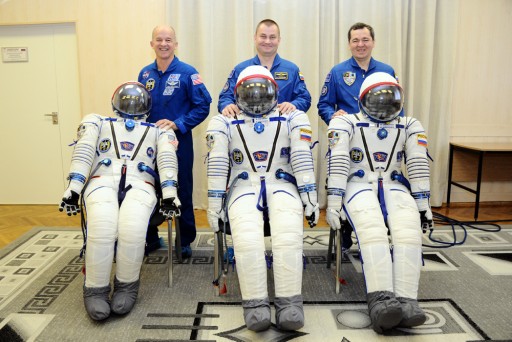
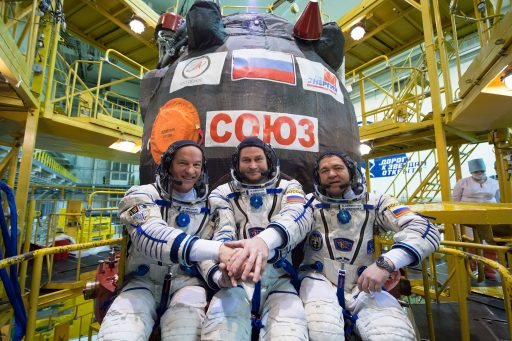
At Site 254, the three crew members go through a final medical check before ingressing their Sokol Launch and Entry suits under assistance by suit technicians to ensure the Sokols can fulfill their task of protecting the crew in the event of a sudden cabin depressurization.
The suits were tested earlier by the crew when completing a simulation inside their Soyuz and leak checks will be repeated for each crew member, one by one, giving the other two a chance to have a face-to-face conversation with family and friends inside the press room.
Five hours and 30 minutes ahead of launch, the Russian State Commission will meet to look at the overall status of the countdown and the results of launch vehicle and spacecraft testing to provide official approval for the beginning of the Soyuz propellant loading sequence. By that time, the tanking carts will have already been rolled up to the pad and hooked up to Ground Support Equipment used to deliver propellants to the Soyuz launch vehicle, loaded via the various umbilical masts connected to the different stages of the rocket to deliver propellant, pressurant and electrical connectivity.
Overall, the Soyuz FG launcher stands 49.5 meters tall and weighs 305,000 Kilograms when fully fueled. It can lift up to 7,200 Kilograms into Low Earth Orbit using a two-stage stack plus four liquid-fueled boosters clustered around the Core Stage.
Each of the boosters is 19.6m long consisting of a tapered and a cylindrical section with a maximum diameter of 2.68m and a launch mass of 43,410 Kilograms. Each is powered by an RD-107A engine delivering 838.5kN of sea level thrust.
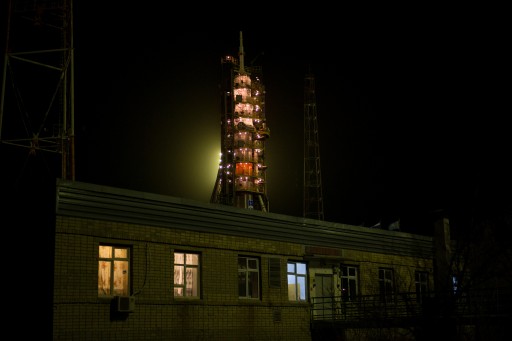
The Core Stage is ignited with the boosters and continues to burn after the boosters separate, acting as first and second stage. It is 27.8m tall and 2.95 meters in diameter with a total launch mass of 99,500kg, powered by a 792-Kilonewton RD-108A engine and four verniers for vehicle control. Sitting atop the Core Stage is the third stage that is 6.74m long, 2.66m in diameter and weighs 25,300 Kilograms equipped with a four-chamber RD-0110 engine and four vernier thrusters for vehicle control.
Propellant loading on the Soyuz FG rocket will commence just inside L-5 hours as the four boosters, the large Core Stage and the third stage on top are filled with refined Kerosene and -183°C Liquid Oxygen that starts flowing into the tanks after an initial chilldown. Additionally, each of the boosters receives 280kg of Nitrogen while the core is filled with 520kg to be heated up in flight to pressurize the propellant tanks.
The crew will depart Site 254 around three hours prior to launch for a 20-minute bus ride over to the historic launch pad at Site 1/5 from where Yuri Gagarin set sail on his flight 55 years ago in 1961 – an anniversary commemorated by an emblem on the launch shroud of this mission.
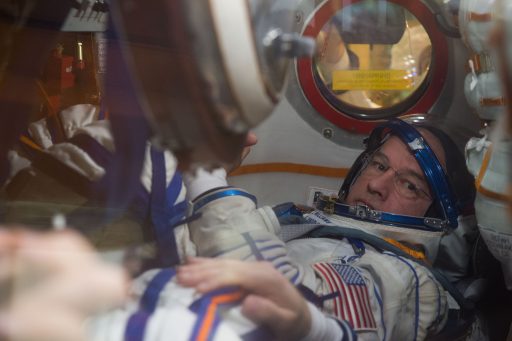
Getting off their bus, the crew members will have a look at their fully fueled rocket, take a few photos with officials present at the pad and walk over to the Service Structure stairs to wave good-bye and enter the elevator taking them up to their Soyuz for crew ingress.
Climbing into the Soyuz through a hatch inside the Launch Shroud, the crew members will – one by one – enter the Orbital Module through its side hatch before climbing down through the Entry Module’s hatch to reach their Kazbek seat liners in the confined space of the small spacecraft that the crew has to share with cargo and equipment. Alexey Ovchinin, a first time space flier, will enter the commander’s seat in the center flanked to his left by Oleg Skripochka, flying the Soyuz for the second time, and Jeff Williams to the right who flew three prior space missions including two on the Soyuz.
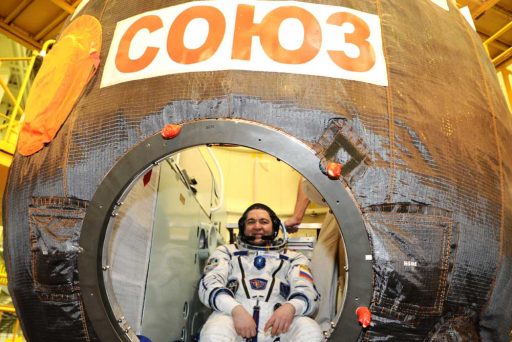
When the crew members are seated, teams will close the Entry Module hatch before the Orbital Module is closed out to have its hatch is closed as well. Next will be a series of leak checks of the Soyuz completed by pressurizing the individual modules of the spacecraft to ensure the internal and external hatches are holding pressure.
The crew members will begin working through their pre-launch checklist that will take them about one hour to complete beginning with a series of communication checks and the initiation of airflow to the Sokol suits. Once the crew members are done with their checklist, the countdown enters a quiet period for them during which they will be entertained with music pumped into the Soyuz through the voice communications system.
60 minutes ahead of launch, the Guidance System is activated and the flight computers receive their flight software 15 minutes later. As hands-on work at the pad wraps up, teams will retract the two halves of the Soyuz Service Structure at L-40 minutes and put all ground systems in a safe configuration. Half an hour before T-0, the Launch Abort System will be activated and switched to automatic mode.
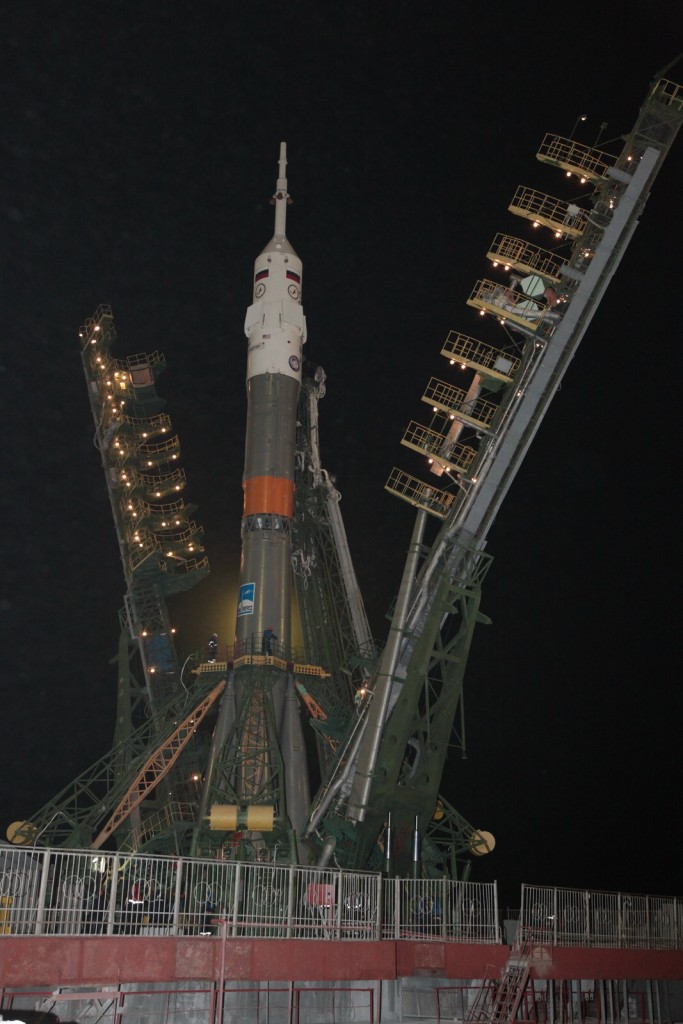
14 minutes ahead of launch, the Soyuz spacecraft is transferred to battery power and at L-10 minutes, the Soyuz FG inertial guidance system is configured for flight as gyros are uncaged and flight recorders are activated. Entering the Automated Countdown Sequence at T-6 minutes, the Soyuz launch vehicle will begin its final reconfigurations as part of a highly choreographed procedure. Inside the launch bunker near the pad, the launch key will be inserted to give clearance for liftoff – a relic of Soyuz’s previous ICBM career.
Soyuz telemetry systems are activated at T-5 minutes and the Commander Controls inside the Soyuz become active. At that point, the crew members will have closed their helmets and switched to suit air.
Four minutes before launch, the five engines of the boosters and core stage are purged with nitrogen before propellant tank pressurization starts at T-2:35 on all 12 tanks of the rocket. Transfer to internal power occurs one minute before liftoff and Soyuz enables its Auto Sequencer that controls the final countdown events. The third stage umbilical is disconnected at T-50 seconds and the service tower retracts ten seconds later. At T-25 seconds, the umbilical tower of the Core Stage is moved to its launch position.
With the Auto Sequencer in control of the countdown, the Soyuz starts its ignition sequence at T-20 seconds as the hydrogen-peroxide-driven turbopumps of the booster and core stage engines soar to flight speed and the engines reach an intermediate thrust level before being throttled up to full thrust for liftoff.
Blastoff is set for precisely 21:26:39 UTC, the optimized launch time based on the latest tracking data of the International Space Station. As clocks hit zero, Soyuz will begin rising from its launch pad with a total launch thrust of 422 metric tons, embarking on a nine-minute ascent mission following the usual flight profile.
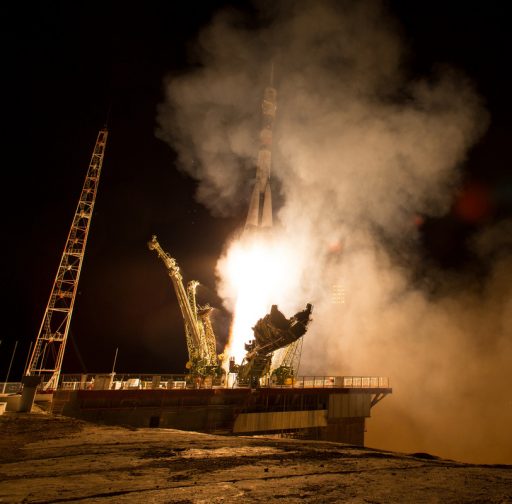
Lighting up the night skies over the Baikonur Cosmodrome, Soyuz FG will begin its pitch maneuver to align itself with the planned ascent trajectory, heading north-east towards the Russian border, homing in on its precise cutoff target to deliver the Soyuz into an orbit at a phase angle of 31.6 degrees to that of the International space Station to make its fast-track rendezvous.
Soyuz FG passes through Maximum Dynamic Pressure and Mach 1 a little over 70 seconds into the flight, being powered by the RD-107A engines of the boosters and the RD-108A of the core. The Launch Abort System jettisons its Escape Tower at 114 seconds into the mission, marking the transition from low- to mid-altitude abort modes in a system that provides launch abort capability all the way to orbital insertion. The four boosters and their RD-107A engines will burn for 1 minute and 58 seconds consuming a total of 39,600kg of propellants to provide extra boost to the vehicle. After shutdown at an altitude of 49 Kilometers, the boosters are jettisoned for a crash landing 348 Kilometers downrange.
With the boosters tumbling away from the Soyuz rocket, propulsion will only be provided by the Core Stage’s engine, delivering a thrust of 102 metric ton force when flying through the rarefied upper atmosphere. Two minutes and 38 seconds after launch, Soyuz will be over 80 Kilometers in altitude and jettison its protective Launch Shroud giving the crew a view outside through their small Entry Module windows as their first sunrise in space approaches, but the crew members will be focused on their displays, tracking the progress of their ascent into orbit.
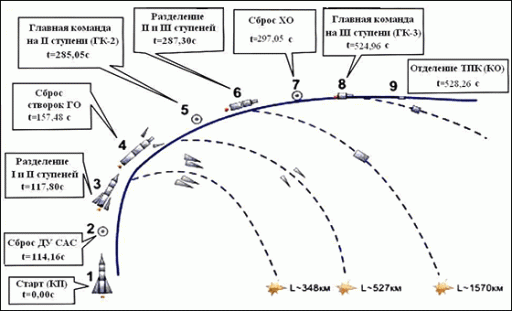
Four minutes and 45 seconds into the flight, the Core Stage will shut down its engine, marking the beginning of the hot staging sequence. Two seconds after cutoff, the third stage’s RD-0110 engine will be commanded to ignite and, at the same time, pyrotechnic bolts in the interstage will be fired to severe the connection between the empty Core Stage and the upper stage of the Soyuz that will continue powered ascent while the core heads towards re-entry and impact 1,570 Kilometers downrange from the launch site.
The third stage will fire its four-chamber engine and four gimbaling verniers for vehicle control until T+8 minutes and 45 seconds to achieve the planned insertion orbit. Just over three seconds after engine shutdown, the Soyuz spacecraft will separate from its rocket stage which itself will open up an oxygen valve to move away from the spacecraft.
Immediately after separation from the carrier rocket, the Soyuz spacecraft will begin executing a series of time-tagged commands. Eight seconds after separation, the deployment of the two-power generating solar arrays and the KURS antennas will be completed. Mission Control Moscow, assuming control of the flight after separation, will follow the critical deployments via telemetry sent to ground stations by the Soyuz spacecraft.
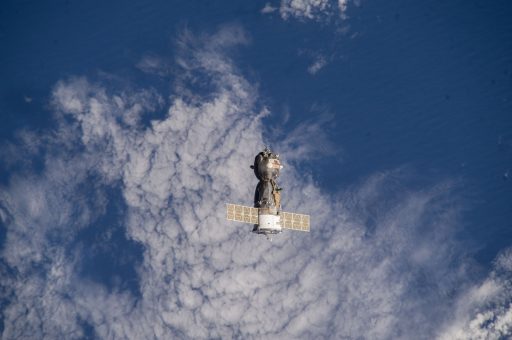
Inside the Entry Module, the crew will not be able to take a break after their exciting ride to space, immediately pressing into a reconfiguration of the Flight Control System and starting a test of the KURS system. Given the compressed timeline of the four-orbit flight profile, teams have to verify KURS is operational before Soyuz heads out of communications range around seven minutes after orbital insertion.
Mission Control will confirm the KURS system is operating as planned and make a quick spacecraft check to ensure it is safe for the crew to loosen their shoulder straps and open up their helmets as they get settled for a six-hour flight to ISS, their destination in space.
Soyuz TMA-20M is targeting the standard insertion orbit of 200 by 242 Kilometers inclined 51.67° from where the spacecraft will climb to meet up with ISS that orbits the Earth in a nearly circular orbit 400 Kilometers in altitude.
Also after orbital insertion, the Soyuz spacecraft will pressurize its unified propulsion system and begin operating its DPO thrusters to reduce body rates that may have been introduced at spacecraft separation.
The four-orbit flight profile requires the Soyuz to begin raising its orbit right away given the tight timeline of the operation.
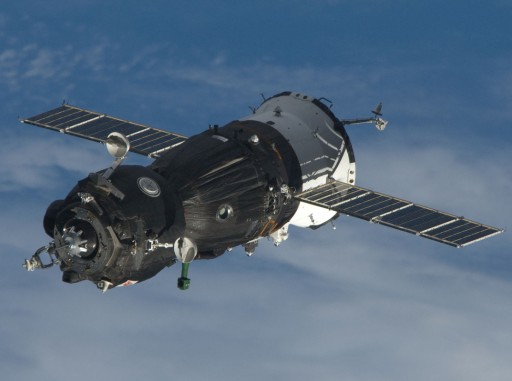
Because there is no time to uplink a revised flight plan based on the actual insertion orbit, Soyuz launches with two engine burns already programmed into its computers for execution on the first lap around the Earth. Tracking is completed after liftoff to determine the precise insertion orbit of the Soyuz which is used to calculate the post DV-2 orbit, then input into mission simulations to update burn parameters for the second orbit. These parameters are uplinked to the spacecraft as part of the first ground station pass following the completion of the first orbit.
Soyuz TMA-20M is set for its first orbit-raising maneuver 46 minutes after launch, half an orbit into the mission. Firing its 300-Kilogram-force SKD main propulsion system for 49 seconds, Soyuz will increase its velocity by 19.6 meters per second and raise both apogee and perigee by about 25 Kilometers.
This burn will be followed by the DV-2 maneuver one hour and 30 minutes into the flight lasting 31 seconds and aiming for a change in velocity of 12.4 meters per second to raise the perigee by 43 and the apogee by 20 Kilometers. Just minutes after the completion of this burn, Soyuz will come within range of Russian Ground Stations again, allowing the crew to report burn progress and receive updated parameters for the upcoming DV-3 and DV-4 maneuvers set to occur during the second orbit. The ground station passes are also used for the continuation of testing and reconfigurations of the Soyuz spacecraft via ground command and through crew inputs.
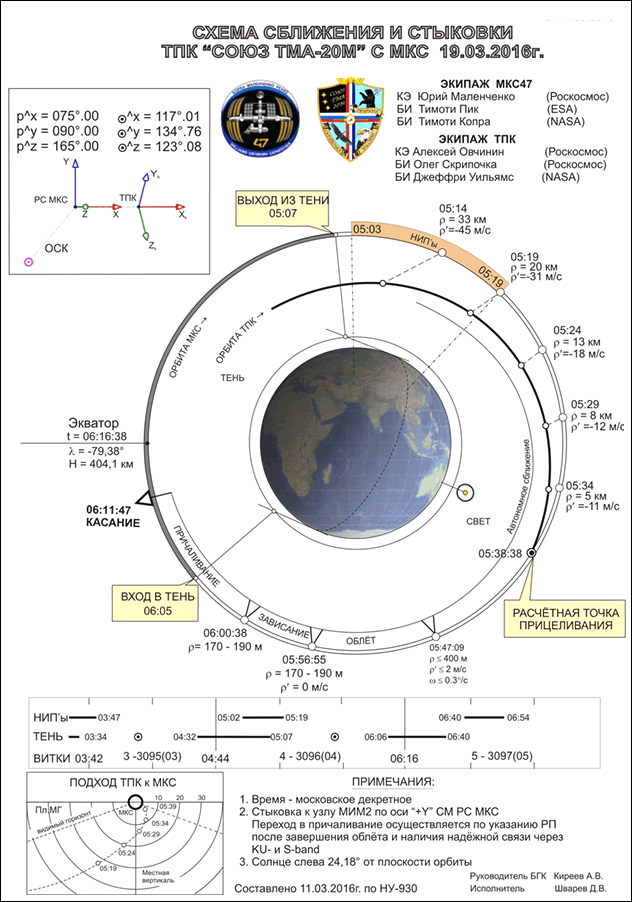
The third orbit-raising maneuver occurs two hours and three minutes after launch and aims for an orbit of 261 by 300 Kilometers followed half an hour later by DV-4 that will boost Soyuz into a 281 by 303-Kilometer orbit. In this orbit, Soyuz will coast until the initiation of the automated rendezvous process at 01:03:38 UTC on Saturday. Another ground station pass will be used by Alexey Ovchinin to operate the rotational and translational hand controllers of the Soyuz to fly it in manual mode for a few minutes to ensure good control would be available in case the need for a manual docking arises.
The DV-5 burn will occur a few minutes after rendezvous initiation and further raise the orbit of the Soyuz, putting it on a path to enter the 200-Kilometer communications zone around ISS at around 1:35 UTC. Arriving at a position 200km from the Station, Soyuz will activate its KURS system and its counterpart on ISS will be powered up as well. Initially searching for the signal, Soyuz will lock on KURS and begin calculating range, range rate and the relative geometry between itself and ISS to guide the craft to the vicinity of the Station through a series of Rendezvous Impulse Burns.
A VHF comm link between Soyuz and ISS will be available to provide Mission Control a continuous data and voice link with Soyuz TMA-20M.
The validity of KURS navigation data will be checked twice, when Soyuz is at 80 Kilometers and closer in at 15 Kilometers to make sure the system is feeding good navigation data to the flight computers. Once arriving in the vicinity of ISS, Soyuz switches on its TV system to provide the crew with a look at the Station.
Initially flying towards a Ballistic Target Point, Soyuz will begin correcting the intentional target offset by making a series of thruster burns that will require the craft to move between burn attitude and Line-Of-Sight attitude.
Reaching a distance of 400 meters to ISS, Soyuz will initiate its flyaround sequence to slowly move around the Station to get aligned with the Poisk module. After the seven-minute sequence, Soyuz will come to a stop 200 meters from the docking port, entering a short period of Stationkeeping so that the crew and the ground can check the alignment. Once Mission Control provides a go for final approach, Ovchinin will issue the command for Soyuz to pulse its DPO thrusters and initiate a slow closing rate.
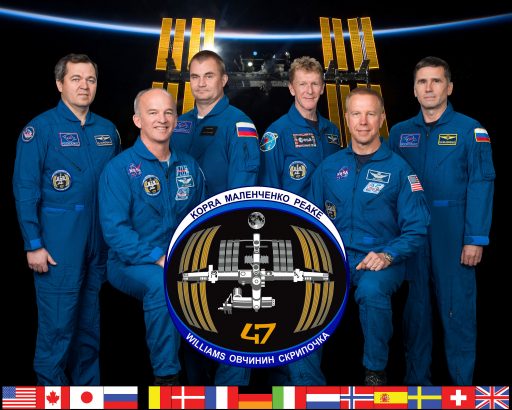
With its DPO thrusters, Soyuz will maintain a good alignment as it slowly moves in for docking. The KURS-AO antenna will be retracted and Soyuz will slow down to 0.1 meters per second for the docking. Contact and capture is expected at 3:11:47 UTC, under six hours after liftoff, to mark the arrival of three crew members at the Space Station for a six-month stay as part of Expedition 47/48. The exact time of docking will depend on the progress of the flight and the time needed during Stationkeeping.
After docking, Soyuz will retract its docking probe and hooks between the Soyuz and Poisk will be closed to establish a tight coupling between the two spacecraft. Leak checks will be conducted while the crew can finally get out of the Sokol launch and Entry suits before opening up the hatch to ISS at around 4:55 UTC.

